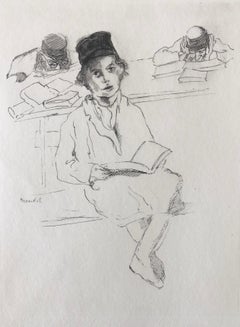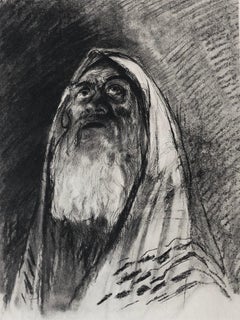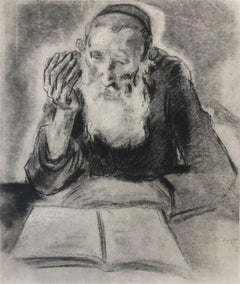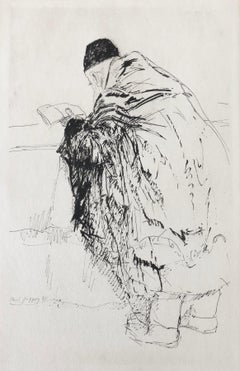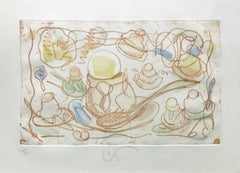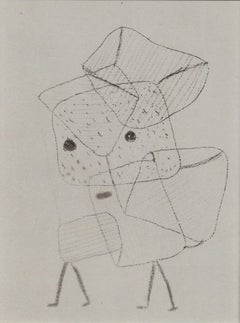Paul Jeffay Figurative Prints
to
9
9
9
Overall Height
to
Overall Width
to
9
9
9
7
6
3
2
1
9
1
11
563
396
350
305
9
1
Artist: Paul Jeffay
Judaica Jewish Shtetl Etching Yeshiva Talmudic Study Vintage Chassidic Art Print
By Paul Jeffay
Located in Surfside, FL
"Qui a raison?"
Chassidic boy, Yeshiva student with open book. Judaica, Jewish scenes from a ghetto.
Saul Yaffie, a.k.a. Paul Jeffay, (1898–1957) was a Scottish Jewish artist. Known for his charming French street scenes as well as his judaica work. This is signed in the plate and dated 1931 in the print. This is done in a style similar to the works of the early Bezalel School artists Hermann Struck and Jakob Steinhardt.
This lithograph, by artist Paul Jeffay depicts a Judaic Shtetl interior scene with great charm and sensitivity.
Saul Yaffie was born in Blythswood, Glasgow on 29 April 1898. His mother was Kate Yaffie (née Karkonoski), and his father, Bernard Yaffie, was a master tailor. Like many Russian Jews, Kate and Bernard Yaffie fled persecution in Russia during a wave of anti-Jewish pogroms triggered by the assassination of Tsar Alexander II in 1881. Saul's father was naturalised as a British citizen by the time that Saul himself was three; a Bernard Yaffie is recorded as living at Abbotsford Place in the old Gorbals, where the young Saul spent the early years of his childhood. The Yaffies were not unique in their situation: the Gorbals was the centre of Scotland's Jewish community and home to a large proportion of Glasgow's immigrants throughout the early 20th century. Over time, there was a movement to some of the more affluent communities in Glasgow, such as Pollokshields and Garnethill, as many Jewish families gradually improved their social and economic situation. Like these, the Yaffies also experienced a time of good fortune, moving to a more agreeable address on Sinclair Drive, Cathcart as Bernard's tailoring business prospered.
Saul attended day classes in drawing and painting, modelling, and life drawing at The Glasgow School of Art from 1912 to 1919. During the First World War, he was required to interrupt his studies to serve in the King's Own Scottish Borderers in 1916/17. Although subject to military conscription, Yaffie reached the rank of corporal during his service. Prior to his conscription Yaffie engaged in munitions work, something that was recorded in the GSA's student registers.
The post-war economic depression that affected the country during the 1920s, also affected the Yaffie family directly: Bernard Yaffie's business suffered greatly, and the family eventually emigrated to Canada. Saul did not emigrate with his family, choosing instead to stay in Europe, and relocate to jazz age Paris where he continued his artistic practice. Now married, Saul sought to escape persecution in Europe by returning to the UK before the Second World War with his wife, Estusia. The two settled in Manchester, but returned to France after the war. In his memoires ‘Bronze in My Blood’, German-born sculptor Benno Schotz describes a Saul ‘Yaffe’, one of only three other Jewish students who attended The Glasgow School of Art at the time. (Schotz himself was exempt from joining the forces because he was ‘not yet a British subject’, and was engaged in war work in the drawing office of John Brown’s shipyards). On the outbreak of the war, Schotz writes, Yaffie won a poster competition to be displayed in Glasgow tramcars at the beginning of the 1914-18 war – his winning design depicted a woman with a child in her arms, fleeing from a fire behind her. While on leave from service, the young Saul told Schotz he had briefly been stationed in the same unit as Jewish American sculptor Jacob Epstein. This was most likely the 38th Battalion of the Royal Fusiliers, also known as ‘the Jewish Legion’, one of five Jewish battalions raised during WW1. ‘He told me how incongruous it was’, remembers Schotz, ‘to See Epstein scrubbing the floor of their hut, with a large diamond ring on his finger’. His work is included in the collection of the Ben Uri Museum in London along with Lucian Freud, David Bomberg, Mark Gertler, Josef Herman, Jankel Adler, Feliks Topolski...
Category
20th Century Expressionist Paul Jeffay Figurative Prints
Materials
Etching
Judaica Jewish Shtetl Etching Hasidic Yeshiva Student Chassidic Print
By Paul Jeffay
Located in Surfside, FL
"Mendel"
Chassidic boy, Yeshiva student with open book. Judaica, Jewish scenes from a ghetto.
Saul Yaffie, a.k.a. Paul Jeffay, (1898–1957) was a Scottish Jewish artist. Known for his charming French street scenes as well as his judaica work. This is signed in the plate and dated 1931 in the print. This is done in a style similar to the works of the early Bezalel School artists Hermann Struck and Jakob Steinhardt.
This lithograph, by artist Paul Jeffay depicts a Judaic Shtetl interior scene with great charm and sensitivity.
Saul Yaffie was born in Blythswood, Glasgow on 29 April 1898. His mother was Kate Yaffie (née Karkonoski), and his father, Bernard Yaffie, was a master tailor. Like many Russian Jews, Kate and Bernard Yaffie fled persecution in Russia during a wave of anti-Jewish pogroms triggered by the assassination of Tsar Alexander II in 1881. Saul's father was naturalised as a British citizen by the time that Saul himself was three; a Bernard Yaffie is recorded as living at Abbotsford Place in the old Gorbals, where the young Saul spent the early years of his childhood. The Yaffies were not unique in their situation: the Gorbals was the centre of Scotland's Jewish community and home to a large proportion of Glasgow's immigrants throughout the early 20th century. Over time, there was a movement to some of the more affluent communities in Glasgow, such as Pollokshields and Garnethill, as many Jewish families gradually improved their social and economic situation. Like these, the Yaffies also experienced a time of good fortune, moving to a more agreeable address on Sinclair Drive, Cathcart as Bernard's tailoring business prospered.
Saul attended day classes in drawing and painting, modelling, and life drawing at The Glasgow School of Art from 1912 to 1919. During the First World War, he was required to interrupt his studies to serve in the King's Own Scottish Borderers in 1916/17. Although subject to military conscription, Yaffie reached the rank of corporal during his service. Prior to his conscription Yaffie engaged in munitions work, something that was recorded in the GSA's student registers.
The post-war economic depression that affected the country during the 1920s, also affected the Yaffie family directly: Bernard Yaffie's business suffered greatly, and the family eventually emigrated to Canada. Saul did not emigrate with his family, choosing instead to stay in Europe, and relocate to jazz age Paris where he continued his artistic practice. Now married, Saul sought to escape persecution in Europe by returning to the UK before the Second World War with his wife, Estusia. The two settled in Manchester, but returned to France after the war. In his memoires ‘Bronze in My Blood’, German-born sculptor Benno Schotz...
Category
20th Century Expressionist Paul Jeffay Figurative Prints
Materials
Etching
Judaica Jewish Shtetl Etching Hasidic Rabbi, Meditation Vintage Chassidic Print
By Paul Jeffay
Located in Surfside, FL
"Le ciel est ouvert"
Older Chassidic rabbi learning with open book, Judaica, Jewish scenes from a ghetto.
Saul Yaffie, a.k.a. Paul Jeffay, (1898–1957) was a Scottish Jewish artist. Known for his charming French street scenes as well as his judaica work. This is signed in the plate and dated 1931 in the print. This is done in a style similar to the works of the early Bezalel School artists Hermann Struck and Jakob Steinhardt.
This lithograph, by artist Paul Jeffay depicts a Judaic Shtetl interior scene with great charm and sensitivity.
Saul Yaffie was born in Blythswood, Glasgow on 29 April 1898. His mother was Kate Yaffie (née Karkonoski), and his father, Bernard Yaffie, was a master tailor. Like many Russian Jews, Kate and Bernard Yaffie fled persecution in Russia during a wave of anti-Jewish pogroms triggered by the assassination of Tsar Alexander II in 1881. Saul's father was naturalised as a British citizen by the time that Saul himself was three; a Bernard Yaffie is recorded as living at Abbotsford Place in the old Gorbals, where the young Saul spent the early years of his childhood. The Yaffies were not unique in their situation: the Gorbals was the centre of Scotland's Jewish community and home to a large proportion of Glasgow's immigrants throughout the early 20th century. Over time, there was a movement to some of the more affluent communities in Glasgow, such as Pollokshields and Garnethill, as many Jewish families gradually improved their social and economic situation. Like these, the Yaffies also experienced a time of good fortune, moving to a more agreeable address on Sinclair Drive, Cathcart as Bernard's tailoring business prospered.
Saul attended day classes in drawing and painting, modelling, and life drawing at The Glasgow School of Art from 1912 to 1919. During the First World War, he was required to interrupt his studies to serve in the King's Own Scottish Borderers in 1916/17. Although subject to military conscription, Yaffie reached the rank of corporal during his service. Prior to his conscription Yaffie engaged in munitions work, something that was recorded in the GSA's student registers.
The post-war economic depression that affected the country during the 1920s, also affected the Yaffie family directly: Bernard Yaffie's business suffered greatly, and the family eventually emigrated to Canada. Saul did not emigrate with his family, choosing instead to stay in Europe, and relocate to jazz age Paris where he continued his artistic practice. Now married, Saul sought to escape persecution in Europe by returning to the UK before the Second World War with his wife, Estusia. The two settled in Manchester, but returned to France after the war. In his memoires ‘Bronze in My Blood’, German-born sculptor Benno Schotz...
Category
20th Century Expressionist Paul Jeffay Figurative Prints
Materials
Etching
Judaica Jewish Shtetl Etching Hasidic Rabbi at Study Vintage Chassidic Print
By Paul Jeffay
Located in Surfside, FL
Older Chassidic rabbi learning with open book, Judaica, Jewish scenes from a ghetto.
Saul Yaffie, a.k.a. Paul Jeffay, (1898–1957) was a Scottish Jewish artist. Known for his charming French street scenes as well as his judaica work. This is signed in the plate and dated 1931 in the print. This is done in a style similar to the works of the early Bezalel School artists Hermann Struck and Jakob Steinhardt.
This lithograph, by artist Paul Jeffay depicts a Judaic Shtetl interior scene with great charm and sensitivity.
Saul Yaffie was born in Blythswood, Glasgow on 29 April 1898. His mother was Kate Yaffie (née Karkonoski), and his father, Bernard Yaffie, was a master tailor. Like many Russian Jews, Kate and Bernard Yaffie fled persecution in Russia during a wave of anti-Jewish pogroms triggered by the assassination of Tsar Alexander II in 1881. Saul's father was naturalised as a British citizen by the time that Saul himself was three; a Bernard Yaffie is recorded as living at Abbotsford Place in the old Gorbals, where the young Saul spent the early years of his childhood. The Yaffies were not unique in their situation: the Gorbals was the centre of Scotland's Jewish community and home to a large proportion of Glasgow's immigrants throughout the early 20th century. Over time, there was a movement to some of the more affluent communities in Glasgow, such as Pollokshields and Garnethill, as many Jewish families gradually improved their social and economic situation. Like these, the Yaffies also experienced a time of good fortune, moving to a more agreeable address on Sinclair Drive, Cathcart as Bernard's tailoring business prospered.
Saul attended day classes in drawing and painting, modelling, and life drawing at The Glasgow School of Art from 1912 to 1919. During the First World War, he was required to interrupt his studies to serve in the King's Own Scottish Borderers in 1916/17. Although subject to military conscription, Yaffie reached the rank of corporal during his service. Prior to his conscription Yaffie engaged in munitions work, something that was recorded in the GSA's student registers.
The post-war economic depression that affected the country during the 1920s, also affected the Yaffie family directly: Bernard Yaffie's business suffered greatly, and the family eventually emigrated to Canada. Saul did not emigrate with his family, choosing instead to stay in Europe, and relocate to jazz age Paris where he continued his artistic practice. Now married, Saul sought to escape persecution in Europe by returning to the UK before the Second World War with his wife, Estusia. The two settled in Manchester, but returned to France after the war. In his memoires ‘Bronze in My Blood’, German-born sculptor Benno Schotz describes a Saul ‘Yaffe’, one of only three other Jewish students who attended The Glasgow School of Art at the time. (Schotz himself was exempt from joining the forces because he was ‘not yet a British subject’, and was engaged in war work in the drawing office of John Brown’s shipyards). On the outbreak of the war, Schotz writes, Yaffie won a poster competition to be displayed in Glasgow tramcars at the beginning of the 1914-18 war – his winning design depicted a woman with a child in her arms, fleeing from a fire behind her. While on leave from service, the young Saul told Schotz he had briefly been stationed in the same unit as Jewish American sculptor Jacob Epstein. This was most likely the 38th Battalion of the Royal Fusiliers, also known as ‘the Jewish Legion’, one of five Jewish battalions raised during WW1. ‘He told me how incongruous it was’, remembers Schotz, ‘to See Epstein scrubbing the floor of their hut, with a large diamond ring on his finger’. His work is included in the collection of the Ben Uri Museum in London along with Lucian Freud, David Bomberg, Mark Gertler, Josef Herman, Jankel Adler, Feliks Topolski...
Category
20th Century Expressionist Paul Jeffay Figurative Prints
Materials
Paper, Etching
Judaica Jewish Shtetl Etching Hasidic Youth at Study Vintage Chassidic Art Print
By Paul Jeffay
Located in Surfside, FL
"Tristesse." (a state of melancholy sadness. "lamenting a lost love, he leaves us poised at the lip of a chasm of tristesse")
Chassidic boy, Yeshiva student with open book. Judaica, Jewish scenes from a ghetto.
Saul Yaffie, a.k.a. Paul Jeffay, (1898–1957) was a Scottish Jewish artist. Known for his charming French street scenes as well as his judaica work. This is signed in the plate and dated 1931 in the print. This is done in a style similar to the works of the early Bezalel School artists Hermann Struck and Jakob Steinhardt.
This lithograph, by artist Paul Jeffay depicts a Judaic Shtetl interior scene with great charm and sensitivity.
Saul Yaffie was born in Blythswood, Glasgow on 29 April 1898. His mother was Kate Yaffie (née Karkonoski), and his father, Bernard Yaffie, was a master tailor. Like many Russian Jews, Kate and Bernard Yaffie fled persecution in Russia during a wave of anti-Jewish pogroms triggered by the assassination of Tsar Alexander II in 1881. Saul's father was naturalised as a British citizen by the time that Saul himself was three; a Bernard Yaffie is recorded as living at Abbotsford Place in the old Gorbals, where the young Saul spent the early years of his childhood. The Yaffies were not unique in their situation: the Gorbals was the centre of Scotland's Jewish community and home to a large proportion of Glasgow's immigrants throughout the early 20th century. Over time, there was a movement to some of the more affluent communities in Glasgow, such as Pollokshields and Garnethill, as many Jewish families gradually improved their social and economic situation. Like these, the Yaffies also experienced a time of good fortune, moving to a more agreeable address on Sinclair Drive, Cathcart as Bernard's tailoring business prospered.
Saul attended day classes in drawing and painting, modelling, and life drawing at The Glasgow School of Art from 1912 to 1919. During the First World War, he was required to interrupt his studies to serve in the King's Own Scottish Borderers in 1916/17. Although subject to military conscription, Yaffie reached the rank of corporal during his service. Prior to his conscription Yaffie engaged in munitions work, something that was recorded in the GSA's student registers.
The post-war economic depression that affected the country during the 1920s, also affected the Yaffie family directly: Bernard Yaffie's business suffered greatly, and the family eventually emigrated to Canada. Saul did not emigrate with his family, choosing instead to stay in Europe, and relocate to jazz age Paris where he continued his artistic practice. Now married, Saul sought to escape persecution in Europe by returning to the UK before the Second World War with his wife, Estusia. The two settled in Manchester, but returned to France after the war. In his memoires ‘Bronze in My Blood’, German-born sculptor Benno Schotz...
Category
1930s Expressionist Paul Jeffay Figurative Prints
Materials
Etching
Judaica Jewish Shtetl Etching Hasidic Rabbi in Prayer Vintage Chassidic Print
By Paul Jeffay
Located in Surfside, FL
. "La priere."
Chassidic Rabbi, Rabbi praying with open book. Judaica, Jewish scenes from a ghetto.
Saul Yaffie, a.k.a. Paul Jeffay, (1898–1957) was a Scottish Jewish artist. Known for his charming French street scenes as well as his judaica work. This is signed in the plate and dated 1931 in the print. This is done in a style similar to the works of the early Bezalel School artists Hermann Struck and Jakob Steinhardt.
This lithograph, by artist Paul Jeffay depicts a Judaic Shtetl interior scene with great charm and sensitivity.
Saul Yaffie was born in Blythswood, Glasgow on 29 April 1898. His mother was Kate Yaffie (née Karkonoski), and his father, Bernard Yaffie, was a master tailor. Like many Russian Jews, Kate and Bernard Yaffie fled persecution in Russia during a wave of anti-Jewish pogroms triggered by the assassination of Tsar Alexander II in 1881. Saul's father was naturalised as a British citizen by the time that Saul himself was three; a Bernard Yaffie is recorded as living at Abbotsford Place in the old Gorbals, where the young Saul spent the early years of his childhood. The Yaffies were not unique in their situation: the Gorbals was the centre of Scotland's Jewish community and home to a large proportion of Glasgow's immigrants throughout the early 20th century. Over time, there was a movement to some of the more affluent communities in Glasgow, such as Pollokshields and Garnethill, as many Jewish families gradually improved their social and economic situation. Like these, the Yaffies also experienced a time of good fortune, moving to a more agreeable address on Sinclair Drive, Cathcart as Bernard's tailoring business prospered.
Saul attended day classes in drawing and painting, modelling, and life drawing at The Glasgow School of Art from 1912 to 1919. During the First World War, he was required to interrupt his studies to serve in the King's Own Scottish Borderers in 1916/17. Although subject to military conscription, Yaffie reached the rank of corporal during his service. Prior to his conscription Yaffie engaged in munitions work, something that was recorded in the GSA's student registers.
The post-war economic depression that affected the country during the 1920s, also affected the Yaffie family directly: Bernard Yaffie's business suffered greatly, and the family eventually emigrated to Canada. Saul did not emigrate with his family, choosing instead to stay in Europe, and relocate to jazz age Paris where he continued his artistic practice. Now married, Saul sought to escape persecution in Europe by returning to the UK before the Second World War with his wife, Estusia. The two settled in Manchester, but returned to France after the war. In his memoires ‘Bronze in My Blood’, German-born sculptor Benno Schotz...
Category
20th Century Expressionist Paul Jeffay Figurative Prints
Materials
Etching
Judaica Jewish Shtetl Etching Reading the Newspaper Vintage Chassidic Art Print
By Paul Jeffay
Located in Surfside, FL
9. "Ouvriers au repos."
Chassidic boy, Yeshiva student with open book. Judaica, Jewish scenes from a ghetto.
Saul Yaffie, a.k.a. Paul Jeffay, (1898–1957) was a Scottish Jewish artist. Known for his charming French street scenes as well as his judaica work. This is signed in the plate and dated 1931 in the print. This is done in a style similar to the works of the early Bezalel School artists Hermann Struck and Jakob Steinhardt.
This lithograph, by artist Paul Jeffay depicts a Judaic Shtetl interior scene with great charm and sensitivity.
Saul Yaffie was born in Blythswood, Glasgow on 29 April 1898. His mother was Kate Yaffie (née Karkonoski), and his father, Bernard Yaffie, was a master tailor. Like many Russian Jews, Kate and Bernard Yaffie fled persecution in Russia during a wave of anti-Jewish pogroms triggered by the assassination of Tsar Alexander II in 1881. Saul's father was naturalised as a British citizen by the time that Saul himself was three; a Bernard Yaffie is recorded as living at Abbotsford Place in the old Gorbals, where the young Saul spent the early years of his childhood. The Yaffies were not unique in their situation: the Gorbals was the centre of Scotland's Jewish community and home to a large proportion of Glasgow's immigrants throughout the early 20th century. Over time, there was a movement to some of the more affluent communities in Glasgow, such as Pollokshields and Garnethill, as many Jewish families gradually improved their social and economic situation. Like these, the Yaffies also experienced a time of good fortune, moving to a more agreeable address on Sinclair Drive, Cathcart as Bernard's tailoring business prospered.
Saul attended day classes in drawing and painting, modelling, and life drawing at The Glasgow School of Art from 1912 to 1919. During the First World War, he was required to interrupt his studies to serve in the King's Own Scottish Borderers in 1916/17. Although subject to military conscription, Yaffie reached the rank of corporal during his service. Prior to his conscription Yaffie engaged in munitions work, something that was recorded in the GSA's student registers.
The post-war economic depression that affected the country during the 1920s, also affected the Yaffie family directly: Bernard Yaffie's business suffered greatly, and the family eventually emigrated to Canada. Saul did not emigrate with his family, choosing instead to stay in Europe, and relocate to jazz age Paris where he continued his artistic practice. Now married, Saul sought to escape persecution in Europe by returning to the UK before the Second World War with his wife, Estusia. The two settled in Manchester, but returned to France after the war. In his memoires ‘Bronze in My Blood’, German-born sculptor Benno Schotz describes a Saul ‘Yaffe’, one of only three other Jewish students who attended The Glasgow School of Art at the time. (Schotz himself was exempt from joining the forces because he was ‘not yet a British subject’, and was engaged in war work in the drawing office of John Brown’s shipyards). On the outbreak of the war, Schotz writes, Yaffie won a poster competition to be displayed in Glasgow tramcars at the beginning of the 1914-18 war – his winning design depicted a woman with a child in her arms, fleeing from a fire behind her. While on leave from service, the young Saul told Schotz he had briefly been stationed in the same unit as Jewish American sculptor Jacob Epstein. This was most likely the 38th Battalion of the Royal Fusiliers, also known as ‘the Jewish Legion’, one of five Jewish battalions raised during WW1. ‘He told me how incongruous it was’, remembers Schotz, ‘to See Epstein scrubbing the floor of their hut, with a large diamond ring on his finger’. His work is included in the collection of the Ben Uri Museum in London along with Lucian Freud, David Bomberg, Mark Gertler, Josef Herman, Jankel Adler, Feliks Topolski...
Category
20th Century Expressionist Paul Jeffay Figurative Prints
Materials
Etching
Judaica Jewish Shtetl Etching Hasidic Rabbi "Difficult Problem" Chassidic Print
By Paul Jeffay
Located in Surfside, FL
"Probleme ardu."
Chassidic boy, Yeshiva student with open book. Judaica, Jewish scenes from a ghetto.
Saul Yaffie, a.k.a. Paul Jeffay, (1898–1957) was a Scottish Jewish artist. Know...
Category
20th Century Expressionist Paul Jeffay Figurative Prints
Materials
Etching
Judaica Jewish Shtetl Etching Hasidic Rabbi Meditation Vintage Chassidic Print
By Paul Jeffay
Located in Surfside, FL
"Meditation."
Chassidic boy, Yeshiva student with open book. Judaica, Jewish scenes from a ghetto.
Saul Yaffie, a.k.a. Paul Jeffay, (1898–1957) was a Scottish Jewish artist. Known for his charming French street scenes as well as his judaica work. This is signed in the plate and dated 1931 in the print. This is done in a style similar to the works of the early Bezalel School artists Hermann Struck and Jakob Steinhardt.
This lithograph, by artist Paul Jeffay depicts a Judaic Shtetl interior scene with great charm and sensitivity.
Saul Yaffie was born in Blythswood, Glasgow on 29 April 1898. His mother was Kate Yaffie (née Karkonoski), and his father, Bernard Yaffie, was a master tailor. Like many Russian Jews, Kate and Bernard Yaffie fled persecution in Russia during a wave of anti-Jewish pogroms triggered by the assassination of Tsar Alexander II in 1881. Saul's father was naturalised as a British citizen by the time that Saul himself was three; a Bernard Yaffie is recorded as living at Abbotsford Place in the old Gorbals, where the young Saul spent the early years of his childhood. The Yaffies were not unique in their situation: the Gorbals was the centre of Scotland's Jewish community and home to a large proportion of Glasgow's immigrants throughout the early 20th century. Over time, there was a movement to some of the more affluent communities in Glasgow, such as Pollokshields and Garnethill, as many Jewish families gradually improved their social and economic situation. Like these, the Yaffies also experienced a time of good fortune, moving to a more agreeable address on Sinclair Drive, Cathcart as Bernard's tailoring business prospered.
Saul attended day classes in drawing and painting, modelling, and life drawing at The Glasgow School of Art from 1912 to 1919. During the First World War, he was required to interrupt his studies to serve in the King's Own Scottish Borderers in 1916/17. Although subject to military conscription, Yaffie reached the rank of corporal during his service. Prior to his conscription Yaffie engaged in munitions work, something that was recorded in the GSA's student registers.
The post-war economic depression that affected the country during the 1920s, also affected the Yaffie family directly: Bernard Yaffie's business suffered greatly, and the family eventually emigrated to Canada. Saul did not emigrate with his family, choosing instead to stay in Europe, and relocate to jazz age Paris where he continued his artistic practice. Now married, Saul sought to escape persecution in Europe by returning to the UK before the Second World War with his wife, Estusia. The two settled in Manchester, but returned to France after the war. In his memoires ‘Bronze in My Blood’, German-born sculptor Benno Schotz...
Category
20th Century Expressionist Paul Jeffay Figurative Prints
Materials
Etching
Related Items
ICE CREAM DESSERTS
By Claes Oldenburg
Located in Aventura, FL
Hand initialed and numbered by the artist. Etching and aquatint in colors, on handmade paper. Image size: 13.5 X 21.25 in. Sheet size: 22.5 x 31.25 in. Framed. Edition of 50. Artwor...
Category
1970s Pop Art Paul Jeffay Figurative Prints
Materials
Handmade Paper, Etching, Aquatint
Paul Klee Etching "Beladene Kinder"
By Paul Klee
Located in Berlin, DE
Helio etching on hand-made paper, 1930 by Paul Klee. From portfolio " Paul Klee, Handzeichnungen 1921-1930. Here no 64.
Image: 7.4 x 5.71 in ( 18,8 x 14,5 cm ), Framed: 15.16 x 13.4...
Category
Mid-20th Century Expressionist Paul Jeffay Figurative Prints
Materials
Etching
Pinchas Burstein ¨Maryan¨, "Untitled", 1975, Lithograph, 24.4x20.9 in n2
By Pinchas Maryan
Located in Miami, FL
Pinchas Burstein ¨Maryan¨ (Polonia, 1927-1977)
'Sin título (verde)', 1975
Lithograph on paper
24.5 x 20.9 in. (62 x 53 cm.)
Edition of 75
ID: BUR1102-002-075
Category
1970s Expressionist Paul Jeffay Figurative Prints
Materials
Etching, Lithograph, Paper, Screen
A Framed 18th C. Piranesi Etching of an Ancient Marble Vase from Hadrian's Villa
By Giovanni Battista Piranesi
Located in Alamo, CA
This large framed 18th century etching by Giovanni Battista Piranesi is entitled "Vaso antico di Marmo adornato di eccellenti Sculture si nella parte anteriere che nell' opposta, le ...
Category
1770s Old Masters Paul Jeffay Figurative Prints
Materials
Etching
H 42.25 in W 26.5 in D 1.5 in
"State 2B", Artist in the Studio Figural Etching, 1974
By Michael Pauker
Located in Soquel, CA
A wonderful small-scale etching of an artist in the studio by Michael Pauker (American, b. 1957). The artist uses fine line work to highlight this finely detailed interior figural sc...
Category
1970s Contemporary Paul Jeffay Figurative Prints
Materials
Ink, Etching, Paper
18th Century Etching of Ancient Roman Architectural Objects by Giovanni Piranesi
By Giovanni Battista Piranesi
Located in Alamo, CA
A. Tigna Protensa Super Media Epistylia, B. Praecisiones Tigorum Quaqua Versus Extrinsectus Apparentium, C. Opae Extremitates Tigorum Contintes, Fig. I, plate 88 from "Vasi, Candelab...
Category
Mid-18th Century Old Masters Paul Jeffay Figurative Prints
Materials
Etching
H 29.63 in W 36.63 in D 1.25 in
Room for One More (New York City Subway)
By Irving Guyer
Located in New York, NY
This Depression-era New York City subway scene says it all. The body language of all five passengers tells us where each of them is in his or her ...
Category
1930s Ashcan School Paul Jeffay Figurative Prints
Materials
Etching, Aquatint
William P. Hicks, Circus
Located in New York, NY
William P. Hicks has drawn everything about the circus that will fit in the plate. The main figure is an aerial act with a woman balancing on rope held by a figure on the floor. Ther...
Category
1930s American Modern Paul Jeffay Figurative Prints
Materials
Etching
Trichromatic Flower-piece, Richard Hamilton multi color flower still life
By Richard Hamilton
Located in New York, NY
According to Gesine Tosin, Richard Hamilton irritated contemporary critics in the 1970s with a series of works -- romantic images of flowers, still lifes and landscapes, interspersed with scatological motifs. "Once exhibited, the critics regarded the paintings as evidence either of a kinky sexual aberration or an early onset of senility." (Hamilton 1982, p.79. ) Trichromatic flower-piece is one of these works, which questioned the categories of high and low art through its appropriated imagery. In the words of Richard Hamilton: “The Shit and Flowers series was was inspired in a sense by Barcelona, walking on the Ramblas where thousands of postcards are displayed. (…) I bought three pictures of flowers. I took them back to Cadaqués and began to play about with them, at first by putting a little paint on the surface.”
According to Andrew Kim Tyler: “Working at Atelier Crommelynck, Paris in 1973-4, Hamilton used a traditional still life subject, a bouquet of flowers, to pursue his interest in the combination of photographic images with planes of color and hand-drawn aspects, but subverting the image with addition of a large turd. Perversely he set out to produce by manual means an etching with the characteristics of a commercially made reproduction resulting in Trichromatic flower-piece.”
In addition to the edition of Trichromatic Flower-piece, Hamilton printed...
Category
1970s Expressionist Paul Jeffay Figurative Prints
Materials
Engraving, Drypoint, Etching, Aquatint
Mujere
By Raul Soldi
Located in San Francisco, CA
This artwork "Mujere" c.1960 is an original color silkscreen by noted Argentinian artist Raul Soldi, 1905-1994. It is hand signed and numbered 12/15 P.A in pencil by the artist. The image size is 22.75 x 17 inches, sheet size is 26.65 x 21.5 inches. It is in very good condition, colors are fresh and bright.
About the artist:
Raúl Soldi was born in Buenos Aire in 1905.
He was an argentine plastic artist of recognized international experience.
In 1920 he began drawing and painting. He makes reproductions of Quinquela Martín...
Category
Mid-20th Century Expressionist Paul Jeffay Figurative Prints
Materials
Screen
Pinchas Burstein ¨Maryan¨, "Untitled", 1975, Lithograph, 24.4x20.9 in n3
By Pinchas Maryan
Located in Miami, FL
Pinchas Burstein ¨Maryan¨ (Polonia, 1927-1977)
'Sin título (rosa)', 1975
Lithograph on paper
24.5 x 20.9 in. (62 x 53 cm.)
Edition of 75
ID: BUR1102-003-075
Category
1970s Expressionist Paul Jeffay Figurative Prints
Materials
Paper, Etching, Screen, Lithograph
Church of St. Costanza, Rome: An 18th Century Piranesi Architectural Etching
By Giovanni Battista Piranesi
Located in Alamo, CA
This is a framed 18th century Giovanni Battista Piranesi etching entitled: "Veduta interna del Sepocro di Santa Costanza, fabbricat...
Category
1770s Old Masters Paul Jeffay Figurative Prints
Materials
Etching
Paul Jeffay figurative prints for sale on 1stDibs.
Find a wide variety of authentic Paul Jeffay figurative prints available for sale on 1stDibs. You can also browse by medium to find art by Paul Jeffay in etching, paper and more. Much of the original work by this artist or collective was created during the 20th century and is mostly associated with the Expressionist style. Not every interior allows for large Paul Jeffay figurative prints, so small editions measuring 12 inches across are available. Customers who are interested in this artist might also find the work of Jacob Steinhardt, Karl Michel, and Colin Self. Paul Jeffay figurative prints prices can differ depending upon medium, time period and other attributes. On 1stDibs, the price for these items starts at $500 and tops out at $500, while the average work can sell for $500.

